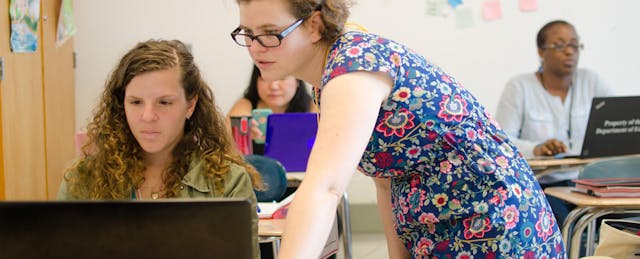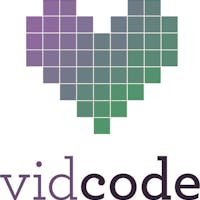“I can barely fix a printer. If there is a non-tech way to do something, I will find it,” says Shanti Crawford, a teacher at P.S. 34 Oliver H. Perry elementary school in Brooklyn, NY. Crawford may have never considered herself to be a "tech person," but she recognized the value of code and discovered how a supportive community could empower her and her students to learn. Now, she’s referred to as LEGO Lady at P.S. 34, where she teaches science, LEGO engineering, and robotics.
Crawford is not alone in having had initial reservations about computer science. New Jersey teacher Julie Andrew-Lamon found that delving into the world of CS for kids was daunting at first. But just like Crawford, she knew how crucial computer science and programming literacy was for her students at Woodland Middle School. Andrew-Lamon faced her fears and brought Hour of Code to her classroom.
Problems (that we all know about)
Educators across the globe are increasingly familiar with the staggering statistics: Between 2010 and 2020, STEM jobs growth will outpace all other jobs at 18.7%, leading to an estimated 1.1 million computing jobs by 2024.
In addition to the number of people needed to propel our world forward through computing, we face another challenge. While women hold 57% of professional occupations, they represent only 25% of the computing workforce; of that 25%, only 9% are women of color. Research has proven that a diversity of information leads to better ideas, so it seems intuitive that we prioritize diversity in technology. Companies like Intel and Apple have launched diversity initiatives, but we have much work to do. And it starts in the classroom.
Problems (that we often overlook) & how to approach them
Even if educators recognize the importance of teaching computer science and programming for their students, they often face their own internal roadblocks. We've highlighted some of the most common ones, as well as tips to get past them.
- Roadblock: I am not a programmer, so I can’t learn how to code. Before Crawford got started, she described herself as a "luddite" and someone who was "tech-averse." Tip: Approach your path to becoming a programmer with a growth mindset. When you can acknowledge to yourself and your students that you too are learning, you free yourself to learn alongside your students.
- Roadblock: Computer programming is too difficult for some of my learners. This is a common misconception; programming tools are an excellent way to reach all of your students. Tip: Ensure you are leveraging peer-to-peer relationships and recognizing that programming can be for different types of learners and different types of intelligences. When Crawford started programming in her classroom with Vidcode, she had an English language learner (ELL) who knew very little English. The student felt successful and included in the programming lessons because she was able to collaborate with her peers and recognize patterns in coding syntax as she would in her native language.
- Roadblock: Only some of my students will be interested in programming. Your students will feed off of your enthusiasm if it’s genuine. Tip: Empower students with choice. Andrew-Lamon suggests surveying your students to determine whether they want to use code to create a game, meme or a Snapchat filter. Try the module first and make sure you as the teacher are excited about it. Additionally, share the benefits of learning how to write code with your students. Crawford found that her students were engaged and inspired as she shared the real-world applications for code and the need for computer programmers in the workforce.
- Roadblock: I am a core content teacher—I don’t need to integrate CS into my lessons. Once Crawford's values outweighed her apprehension, she grew to love finding ways to incorporate coding into her classroom. Tip: Include flexible days in your scope and sequence at the beginning and end of units. You can revisit coding throughout the semester or year, and also use code as an everyday tool. From a professional development perspective, Crawford now has the mindset that anything that helps make learning sticky—such as having students create a news channel—can be made with code.
- Roadblock: I am the only one trying to do this. It can feel like you’re on an island if your school or district has not yet prioritized computer science. Tip: Find a community. You might seek out professional development through coding platforms, attend free meet ups like those hosted by CSNYC, or connect online through groups such as Vidcode’s Educator Community. Through discussions with others, both Crawford and Andrew-Lamon found that programmers came from all different pathways such as filmmaking, literature, and music. When they experienced the power of connection, they were able to enjoy and value the multiplier effect of peer-to-peer learning—which they shared with their students. Stress that coding is done in partnership, community and friendship.
- Roadblock: I feel overwhelmed by the amount of resources and don’t know enough to get started. Crawford started with MIT’s Scratch, which uses drag and drop blocks to help teach young students to learn computational thinking. Looking for something to try next, she found sifting through the variety of available tools challenging. Crawford ultimately decided that Vidcode provided the balance of sequencing, rigor, and creativity she was looking for after Scratch. How can you approach the multitude of options? Tip: Make something. Make anything. Check out Code.org’s projects, pick one, and make something. Once you try a module, teach that one module to your students. Then sift through additional grade-level-appropriate resources, and take into consideration the depth and cohesion you’re looking for in your software.



